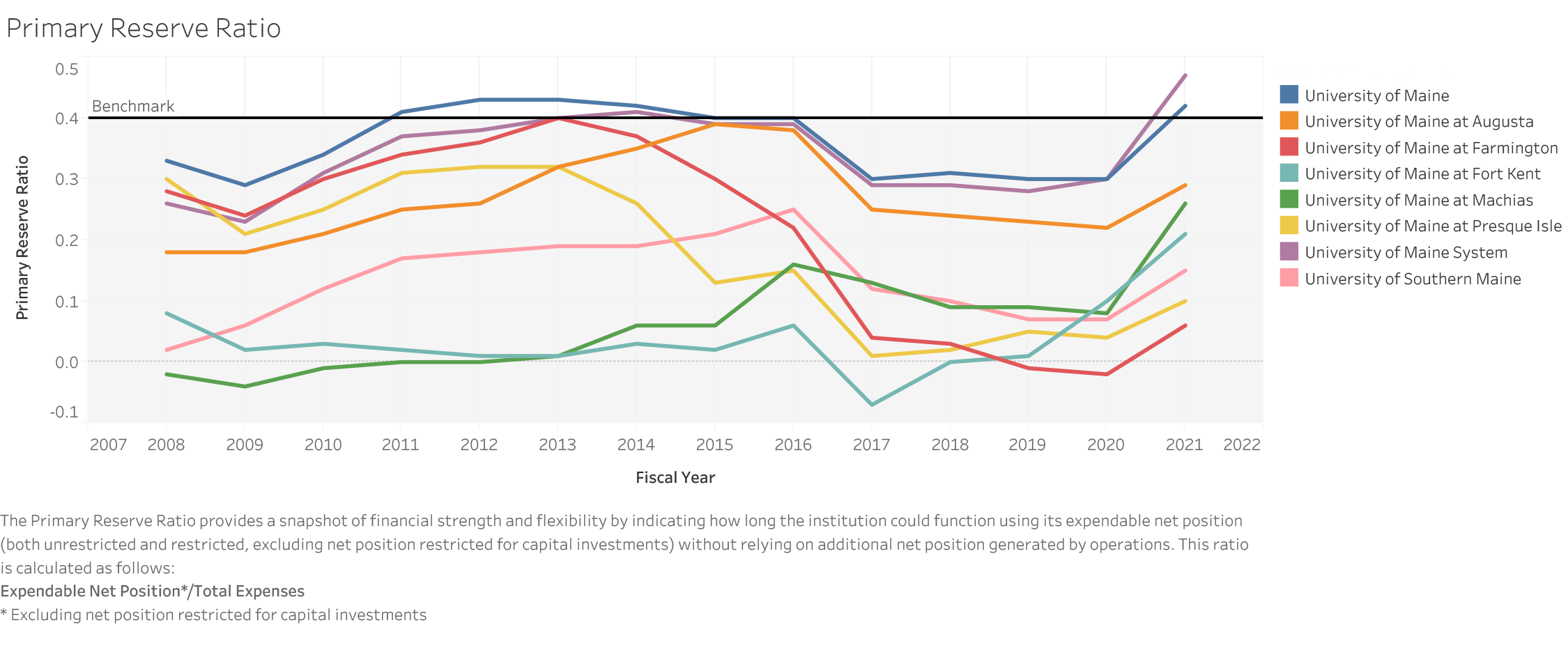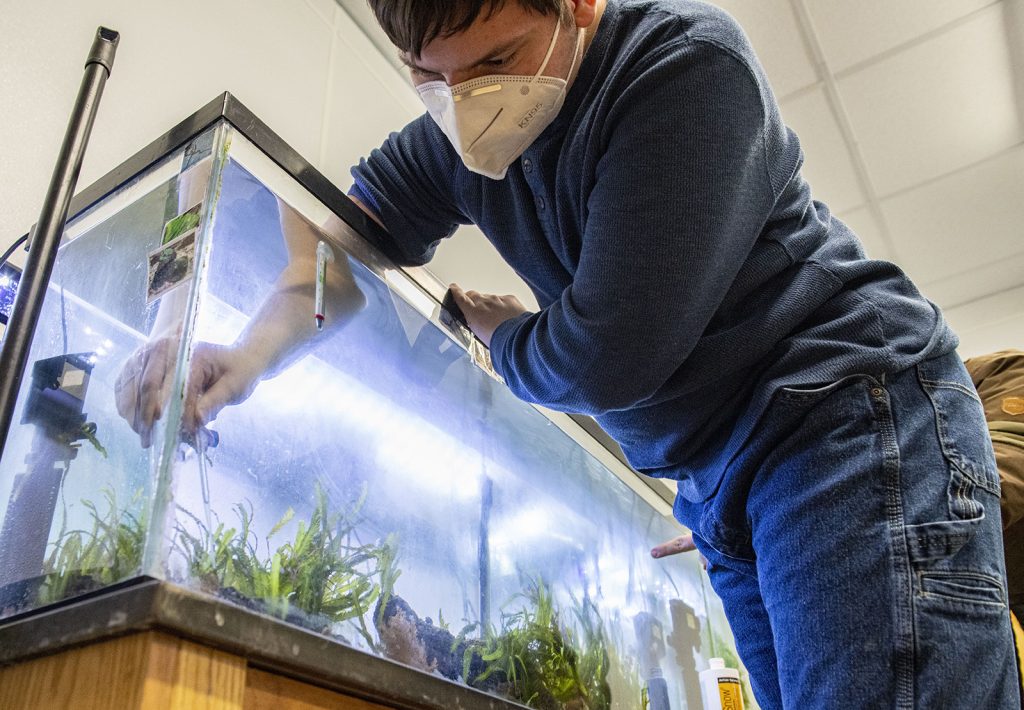Upon granting unified accreditation to the University of Maine System in July 2020, our regional accreditor, the New England Commission of Higher Education (NECHE), asked us to prepare a self-study in advance of a Fall 2022 visit by a NECHE-appointed evaluation team. Standard Eight: Institutional Resources can be found on this page.
UMS continues to be well-positioned to comply with this Standard. System-wide groups representing each of the Standard Seven components are in place and have made progress toward shared systems and goals. For financial resources, the period under evaluation has presented extraordinary challenges due to COVID-19; however, work has moved forward on our near-term and long-term financial planning. Centralized IT continues to evolve with integrated governance and planning.
While changing pedagogies and technologies present significant challenges, the effective shift to remote learning System-wide in March 2022 and the implementation of a new learning management system in fall 2022 were major achievements. In addition, UMS libraries have finalized a strategic plan, and UMS is engaged in facilities planning and investment with an increased major capital load of more than $100 million. Maximizing these institutional resources will continue to benefit UMS and its universities.
Description
Human Resources: overview
The University of Maine System (UMS) Office of Human Resources (OHR) provides leadership in collaboration with each UMS university to meet the changing human resource needs of faculty, staff, and students and ensure that UMS provides educational opportunities that transform students’ lives and research and outreach contributing to the people and state of Maine. Fair and respectful treatment of employees and compliance with employment laws are among OHR’s core values.
As of October 2021, UMS had 4,721 FTE employees, including by headcount 1,238 regular faculty, 846 adjunct faculty, 2,006 salaried staff, 1,204 hourly staff, and 97 administrators. UMS employs a centralized human resources and labor relations function (54 FTE) under the direction of a Chief Human Resources Officer (CHRO) reporting to the Vice Chancellor for Strategic Initiatives and Chief Legal Officer (VCSI). Centralized services include benefits and payroll administration, HRIS, compensation, equal opportunity, ADA compliance, labor relations, talent acquisition, and learning and organizational development. Common policies, practices, and procedures apply across UMS.
Each UMS university is assigned a Human Resources Partner (HRP) with dual reporting lines to the CHRO and the university President. Collective bargaining is conducted for six bargaining units at the UMS level with participation from each university, and all collective bargaining contracts apply across UMS. HR also supports student employees with their set-up in the HR system and their payroll.
In Fall 2021, a monthly CHRO newsletter was developed to reach employees System-wide, providing important information and connecting employees to OHR. Each newsletter features a different monthly theme and announcements and reminders about upcoming events, deadlines, and opportunities. The newsletter supplements local HR communications across UMS.
Human Resources: strategic initiatives
OHR has launched a live (virtual) System-wide new hire orientation for navigating the basic employee landscape and reviewing employee benefits, as well as monthly virtual meet-and-greet sessions with UMS staff to welcome and support new hires. This orientation was developed with the goal of ensuring that all new hires experience multiple human interactions throughout the onboarding process despite geographic and COVID-related challenges. The virtual orientation is provided in addition to orientation efforts made locally at each university.
OHR has also developed an HR lecture series to offer programming related to topics such as navigating the pandemic, managing stress, mental health considerations, and mindfulness techniques.
In addition, OHR has begun a comprehensive review of UMS Human Resources policies and procedures, including the Employee Handbook. Upon completing the review, OHR will make any necessary revisions to its policies and procedures to ensure they align fully with UMS goals and values.
OHR is working to create new positions within human resources that will help in achieving UMS’ strategic goals. Recently, OHR has focused on filling critical roles such as the Director of Labor Relations, Vice President of Total Rewards, Equal Opportunity Investigator, and Internal Communications Director. These positions will be instrumental in helping to carry out System goals and initiatives.
Human Resources is working cross-functionally with key stakeholders to implement a new payroll system that will help employees who struggle with the current monthly payroll schedule. The new system will significantly improve the payroll process overall, and the cost savings it realizes will be used to support other initiatives.
OHR co-leads DEI efforts across the state by building on a framework developed by the Chancellor, Presidents, university DEI councils, and HR’s Learning and Organizational Development staff following the Chancellor’s June 2020 Imperative for Change directive. UMS recently deployed the HEDS DEI Climate Survey System-wide and will use the resulting data to tailor DEI efforts and programs moving forward.
Financial structure, operations, and resources
The UMS Charter (P&SL 1985, chapter 532 as amended, Section 4-B.1.; Bylaws of the Board of Trustees Section 1.3) states that the Board of Trustees is the UMS governing and planning body, and charges it with responsibility for preparing and approving the operating and capital budgets. The Board is responsible for providing sound financial management and exercise prudent stewardship of UMS assets, and plan strategies for programs and allocation of resources that most effectively serve the educational needs of the citizens of Maine.
The Charter (Section 4-A, 4-B2) also states that the Board will appoint a Chancellor as chief administrative and education officer. Among other duties, the Chancellor promotes planning for financial operations, capital plans and resource allocations; prepares all operating and capital budgets, appropriation requests, and bond issues; and provides centralized management oversight of services.
Section 2 of the Charter states that the Board will appoint a Treasurer to receive and have custody of all money received for UMS, make all expenditures upon authentication, exercise revenue bonding authority with the approval of the Board, and prepare the annual UMS financial report. Board Policy 207 rests all signatory authority to draw funds and to sign contracts, grant applications, research proposals, purchase orders, and similar instruments with the Treasurer.
In current practice, the Vice Chancellor for Finance and Administration (VCFA) also serves as the appointed Treasurer of the Board and exercises the powers reserved to the treasurer under Maine law. In addition, the VCFA fulfills the other financial and administrative duties assigned by the Board and delegated to that position by the Chancellor.
The VCFA is the UMS chief financial officer. Pursuant to a directive of the Board in November 2013, the VCFA developed a unified financial structure for UMS, including centralized services for budget, financial analysis, finance/controller, and student accounts. The Chief Business Officer (CBO) of each UMS university has a dual reporting line to the VCFA and the university President.
All Board and administrative fiscal policies are promulgated on the UMS website and kept current. A UMS administrative policy on the Use of University Funds was adopted in 2013 to ensure that all funds are expended for business purposes that support and advance the UMS mission.
A new Board policy on the development and management of operating and capital budgets was adopted in 2014 to provide an engaged and iterative process for developing the UMS budget that ensures the fiduciary responsibilities of multiple stakeholders (Board, Chancellor, VCFA, and university Presidents) are met, and that the Chancellor and Presidents have the opportunity to engage campus and community constituencies in the process. Additionally, the new policy provides central controls and approval requirements to manage the budget.
UMS applies best practices to monitor and report on its financial health to the Board and the public, including multi-year financial analysis to project five-year revenues and expenditures; current fiscal year (FY) forecasting to project year-end results at intervals during the fiscal year; and financial ratio analyses to monitor the financial health of each university and UMS over time.

| Campus | 2018 | 2019 | 2020 | 2021 |
|---|---|---|---|---|
| UMA | 13324000 | 14341000 | 14180000 | 14442000 |
| Umaine | 108076000 | 112774000 | 111104000 | 114398000 |
| USM | 52255000 | 53997000 | 54246000 | 54070000 |
| UMPI | 4130000 | 4060000 | 3903000 | 4405000 |
| UMM | 2038000 | 1685000 | 1677000 | 1647000 |
| UMFK | 6013000 | 5796000 | 5388000 | 5373000 |
| UMFK | 11348000 | 11272000 | 10848000 | 9881000 |
UMS maintains a Budget Stabilization Fund (currently $12 million) to supplement revenues and stabilize the budget during enrollment declines and economic downturns, and a Strategic Investment Fund for critical non-recurring investments (currently $2.5 million annually). The System also maintains a Benefit Pool carryover reserve of $19.5 million to smooth the financial impact of adverse claim trends in its self-insured health plan. In addition, UMS is in its third year of implementing an appropriation allocation funding model that links the allocation of new State appropriation to the funding levels of its universities’ peers.

UMS’s finances are regularly reviewed by three standing committees of the Board: the Finance, Facilities and Technology Committee (FFT) has general responsibility for financial oversight; the Investment Committee is responsible for the conservation and prudent management of the managed investment pool, including the endowment, the defined benefit pension fund, and the operating cash fund; and the Audit Committee monitors the adequacy and integrity of UMS’s internal controls, financial reporting, compliance with legal and regulatory requirements, risk assessment, and ethics reporting. Each committee reports regularly to the full Board for approval of key decisions. UMS finances are subject to annual independent financial statement audits and to the Uniform Guidance audit of federal funds.
Despite ongoing economic and demographic challenges, UMS has been able to set aside resources for strategic investments and unforeseen events. As a result, the collective financial condition is relatively stable. In each of the past five fiscal years, UMS’s net position has increased from the net of revenues over expenses.
Like all other public higher education institutions, UMS has adopted Governmental Accounting Standards Board (GASB) Statement No. 75 (Accounting and Financial Reporting for Post-employment Benefits Other Than Pensions). UMS adopted the statement in FY17, reducing its beginning-of-year net position by a one-time amount of $102 million as it recorded the full liability for its post-employment health plan. Since that time, net position has decreased three percent or ($34) million, to a total of $832 million as of June 30, 2020.
Operating revenues have increased by 3.2% from $436 million in FY16 to $450 million in FY20. Net student tuition and fee revenues are the primary source of operating revenues and have grown 18.2% from $270 million in FY16 to $319 million in FY20 despite Fall 2020 full-time equivalent enrollment of 21,618 being relatively flat compared with Fall 2015 full-time equivalent enrollment of 21,629. In FY18, UMS increased tuition for in-state undergraduate students for the first time since FY12.
Continuing with its commitment to affordable educational opportunities, UMS held the in-state undergraduate tuition increase at that time to an average of 3.3% and the overall average comprehensive costs of education for this same category of students to an increase of 2.7%. The FY20 in-state undergraduate tuition increased by an average of 2.7% where the overall average comprehensive cost of education for this same category of students increased 2.8%.
UMS has a comprehensive enrollment management plan that is updated annually. Enrollment is supported by financial aid funded by each of the universities, including tuition waivers, scholarships, SEOG match, work-study match, university loans, and Perkins/Nursing match.
Net non-operating revenues increased by 19.3% from $222 million in FY16 to $265 million in FY20. Non-capital state appropriation has increased by 9% from $201 million in FY16 to $219 million in FY20. Gifts currently expendable have been relatively flat over the past five years and totaled $19.4 million in FY20. Endowment return used for operations has been consistent at $6 million per year for the past five years.
Investment income has fluctuated with changes in the investment market. Such revenue totaled $9 million in FY20, and averaged $9.3 million for the past three years and $8.2 million over the past five years. UMS engages a consultant to provide guidance on its investments and has in place written investment guidelines and objectives approved by the Investment Committee of the Board.
UMS operating expenses increased by 8.4%, from $660 million in FY16 to $716 million in FY20. The combined total operating expenses for instruction, academic support, and student services was $318 million for FY20, representing 44% of total operating expenses. This percentage has been relatively consistent over the past five years. In keeping with GASB, UMS is committed to including depreciation costs in its capital and operating budgets so it can address ongoing facility renewal and replacement and its backlog of repair and modernization needs.
Twelve affiliated fundraising organizations (e.g. foundations, alumni associations) provide support to UMS missions and initiatives. University foundations provided an annual average of $11.7 million in gifts to UM over the past five years. Total endowment market values for all affiliated fundraising organizations totaled $134 million at the end of FY20, up 14 percent from the FY16 total of $118 million.
UMS has developed a long-range financial planning process—the Multi-Year Financial Analysis (MYFA)—that evaluates the fiscal impact of key budget drivers such as enrollment, faculty and staff compensation, investments in physical plant, and state appropriation invested in UMS. The MYFA is supported by a comprehensive financial modeling tool for multi-scenario, all funds revenue, and expense forecasting, including demographic, program, and facilities analysis. The MYFA is reviewed with the Board annually as part of the budget review process to inform and guide decision-making and resource allocation.

Facilities
UMS has developed a central capital planning and project management function, and centralized risk management, strategic procurement, safety management, and a unified work control center. These operations are led by a Chief Facilities and General Services Officer reporting to the VCFA. UMS universities manage day-to-day operations of facilities and grounds; their respective facilities directors report to the university Chief Business Officers (CBOs).
UMS owns and operates a physical infrastructure of about 8.7 million square feet of space (a reduction of about 3 percent since approximately 2012), hundreds of buildings, and thousands of acres of land at its universities and Law School and at numerous additional physical locations, including farms, forests, marine and aquaculture research facilities, and off-campus instructional locations.
Libraries
Fulfilling a goal identified in the June 2020 UMS substantive change request to the Commission, the University of Maine System Libraries (UMSL) group completed a strategic plan in 2021.
UMS libraries’ shared collections support students, faculty, staff, and researchers, including all resources acquired in print, e-journals, e-books, databases, various media, and special collections. Through these resources, the libraries support curricula, programs, and research at their respective universities through owned or accessible collections, inter-library lending, and course reserves.
Available resources include discovery and content management tools, focused Lib Guides web pages for subject areas, programs and classes, and local web pages and other tools created or mediated by UMS librarians. Other resources include:
Maine InfoNet: a statewide collaborative of academic, public, school, and special libraries.
URSUS: the UMS libraries, Bangor Public Library, Maine State Library, and Maine State Law and Legislative Library.
Larger Libraries Group: UM, USM, Bowdoin, Bates, Colby, Bangor Public Library, Maine State Library, Portland Public Library, and the University of New England.
Maine Shared Libraries Cooperative: a collaborative of 40+ academic and public libraries in Maine who have collectively agreed to retain more than 1.5 million print books for a minimum of 15 years.
Information technology
UMS employs a centralized information technology (UMS:IT) function to meet the expectations and purposes of its students, faculty, and staff. These operations are led by the Chief Information Officer (CIO), who reports to the VCFA. UMS:IT delivers technology infrastructure, solutions and services to the universities and other UMS units. The team was unified in 2013, streamlining governance, assets, and delivery systems, while maintaining direct response capability at each university. The resources assigned to UMS universities operate under a common set of standards and principles to achieve System outcomes.
UMS operates a singular wide-area network, providing a single high-speed network to connect all locations, students, faculties, and support. Online and hybrid services are supported by IT and by instructional design staff at all locations.

Regular investments are made to maintain technical capacity at each UMS physical location. Specific emphasis is placed on learning technologies, including video, smart board, wireless capacity and other infrastructure to support and enhance learning.
UMS’s IT capital investment plan demonstrates recent and future planned expenditures. The Education Technology Advisory Committee (ETAC), a group consisting of faculty, instructional design professionals, and IT staff who identify emerging instructional technologies, evaluate new products and services, and provide investment and service-design advice.
A Chief Information Security Officer (CISO) reports to the CIO. The CISO oversees systems integrity and privacy of data and is the UMS HIPAA designee managing unified policy, actions, and security incidents. Training of all staff and proactive audits and log management fall in the CISO’s area of responsibility. A revitalization of the UMS:IT governance board will continue oversight by faculty, academic leadership, and administrative management.
University learning and collaborative spaces are designed to be inviting and highly functional for students and other users. Environments have been upgraded to support bring-your-own-device strategies and mobility. UMS operates a regional optical network at all its universities to provide the necessary bandwidth and capacity to support research and advanced needs.
UMS completed its first Information Technology Strategic Plan in 2018, identifying strengths and gaps in information resources, services, and capacity across UMS. This analysis is updated annually.
Appraisal
Human Resources
With its new CHRO in place as of October 2021, OHR is conducting a complete review to identify opportunities and build upon strengths, including consideration of its matrix structure, labor relations staffing, support, and coordination, technology investments, and administration of the Great Colleges to Work For survey.
Increasing access to library resources across UMS
Students enrolled in courses at multiple UMS universities have ready access to shared resources. Faculty, staff, and researchers do not, as individual library budgets will not allow for vendor licensing for the full array of potential resources. (Vendor licensing costs are typically based on a tiered range of FTE students.)
A plan and process are needed to ensure that all university constituencies have equitable access to library resources across UMS. Relatedly, continued research into a shared acquisitions model with a single budget is imperative. This approach would promote ease in resource-sharing and ensure access across UMS.
A library resources task force formed in 2017 recommended that UMS take one of two approaches to library resource equity: 1) Provide all UMS libraries digital resources to faculty, staff, and researchers at all seven universities and the Law School; or 2) provide several of the most commonly needed resources. The mechanism for funding 1) or 2) suggested at the time is the establishment of a per-credit library fee.

Facilities and infrastructure
Several facilities require communications and infrastructure upgrades, and keeping pace with evolving pedagogy and technologies is challenging. For this reason, integrated governance and planning for UMS:IT, including significant collaboration with UMS universities, is used to set policies, achieve support, and establish a cycle of continuous feedback and improvements. Deeper integration of the information technology systems serving UMS universities is occurring and will result in greater efficiency and interoperability while enhancing student success.
UMS also has sought novel sources of investment. Revenue bonds, public-private partnerships, potential new state support, energy services company agreements, and other revenue sources are being pursued or are in progress above and beyond more traditional appropriation funds, grant, or general obligation bond resources.
UMS contracts with Sightlines/Gordian to help monitor and manage its physical infrastructure. Physical space is generally appropriate and adequate, but disparities exist. UMS engages in ongoing planning and investment to improve the design and condition of its facilities, and to keep current with teaching methodologies and the ever-changing needs of students and faculty.
In addition to its existing facilities, UMS is managing (as noted above) a major capital project load of more than $100 million in projects, an increase from its previous $45 and $70 million range. These are often multi-year projects, and the increase reflects significant new funding sources, such as private philanthropy, state support, and private partnerships, as UMS continues its effort to improve the condition and net asset value of its facilities.
UMS engages periodically in physical resource planning, including annual assessment of the condition and needs of the physical infrastructure. UMS employs a three-tiered planning process that includes master planning approximately every decade, five-year capital planning exercises, and annual work planning to be integrated into UMS’s annual budget process.
Information technology
Prior to 2012, information technology investments and decisions were made individually by UMS universities, and technologies were not standard from one location to another. Lack of consistency in data coding conventions and standards has also presented challenges in delivering consistent functionality and user experiences for core systems. Resources needed to enable sufficient high-level IT capacity at all instructional locations represent a continued investment.
To address these issues, integrated governance and planning for UMS:IT, including significant collaboration and flexibility with UMS universities, will be used to set policies, achieve support, and establish a cycle of continuous feedback and improvements. Deeper integration of the information technology systems serving UMS universities is occurring and will result in greater efficiency and inter-operability while enhancing student success.
Continued growth in the UMS Data Governance structure will promote and ensure greater consistency with data coding conventions and standards. Continuation of the effort to adopt a cloud-first enterprise strategy will ensure long-term scalability, sustainability, and cost efficiency.
Finances

UMS finances remain strong. The institution carefully tracks state and regional demographics and enrollment activity, and pursues cost savings and operational efficiencies wherever feasible while maintaining appropriate services and programming for students, faculty, and staff.
Projection
While many facilities are in excellent condition, the overall state of UMS facilities is estimated at a net asset value of approximately 54%, and more than half of all space has a renovation age of 50 years or older. The Board has set a goal of achieving a net asset value of 63% by 2022, a target subject to review and updating.
To address facilities challenges, UMS continues to focus on removing space, constraining the growth of space, and thereby improving overall net asset value. UMS has reducing its total space by 285,000 gross square feet since FY12 and that initiative is ongoing.
UMS efforts to secure new and novel sources of investment have produced gains in the overall funds available— one-time and recurring— for major capital projects in the current capital planning period and the immediate future. Revenue bonds, public-private partnerships, potential new state support, energy services company agreements, and other revenue sources are all being pursued or are in progress above and beyond the more traditional appropriation funds, grants, and general obligation bond resources.
